Introduction
Much of the media coverage surrounding young people and online social networks has focused on the type and amount of personal information teens make available on these networks. Are they sharing information that will harm their future college or job prospects? Or worse, are they sharing information that puts them at risk of victimization?
We set out to examine how teens understand their privacy through several lenses: by looking at the choices that teens make to share or not to share information online, by examining what they share, the context in which they share it and their own assessment of their vulnerability. For many online teens, particularly those with profiles, privacy choices are made manifest in the information shared in a social networking profile. Of course, material shared in a profile is just one of a larger number of places where information is shared online – but it provides a snapshot into the choices that teens make to share in a relatively public and persistent online environment.
“Just pictures. And not obscene pictures. Like if my Mom saw it I wouldn’t care. I’m really careful with that whole MySpace thing. I’ve heard of employers not hiring people because of it. So I just put things up there that if my Grandma or Mom saw it I wouldn’t care. It wouldn’t be a big deal.”
– Girl, Late High School
In order to understand these issues better, we asked a series of questions both in representative national phone surveys and in focus groups that gauged teens’ sense of privacy relating to sharing personal information. We wanted to understand how teens make decisions to share information both in online and offline contexts. Two scenarios were presented in our survey and focus groups: First, we asked teens about the kinds of information they might consider sharing with someone they had just met at a party or other social situation, and we followed with questions regarding the information teens have shared on an online profile.
What is okay to share online? Teens prefer to keep it vague.
For many teens, a first name is okay to post online since it is relatively generic. More than 4 out of 5 teens (82%) with online profiles post their first name to their profile. Photos are also frequently posted by teens to their profiles, with 79% of teens posting a photo of themselves and 66% posting photos of friends to their online profiles. When asked in focus groups whether they had any concerns about publicly posted photos, most teens said they were not worried about risks to their privacy. They felt that, for the most part, there was not enough information in the photos posted, even when combined with the information contained in the profile, to compromise their privacy or safety. Other teens told us that they had set their profiles to private or deliberately made their age younger to achieve a higher level of restricted access built into the social network they use. This allows them to protect their privacy while still sharing information with an approved group of friends.
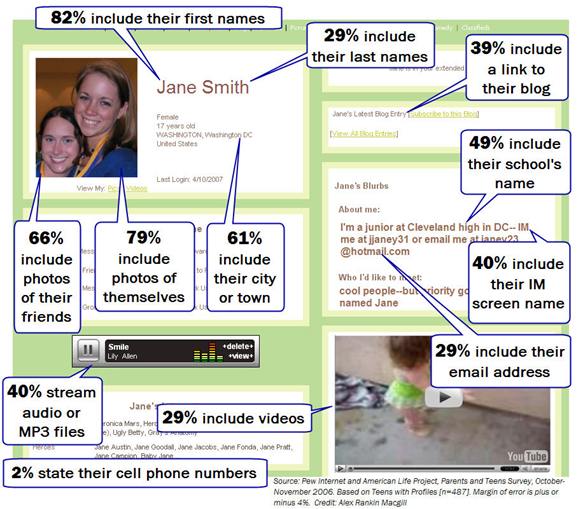
The “city or town where you live” is posted to the profiles of 6 in 10 teens who have online profiles. And just about half of teens say they have put their school name up online. Four in ten teens say they have posted their IM Screen name, streaming audio or mp3 files, or access to their blog. Three in ten teens say they have posted their last name, their email address, or a video file to their online profile. A mere 2% of teens have posted their ultra-personal cell phone number to their online profile.
Few teens disclose their full name on public profiles.
Overall, 14% of online teens post both their first and last name to their online profile. Looking at the data another way, 26% of teens with online profiles post their full names. However, most of these teens who include their full name restrict access to their profile; just 6% of online teens and 11% of profile-owning teens post their first and last name to a publicly viewable profile that is visible to anyone online.
Just 7% of online teens say they post their full name, a photo of themselves, their school name, and the city or town where they live to their online profile. This represents 13% of all profile-owning teens. Again, most of these “transparent teens” restrict who has access to their profile; just 3% of online teens, and 5% of profile-owning teens disclose all of these details on a publicly viewable profile.
Girls and boys have different levels of disclosure on their online profiles.
Girls and boys make different choices about giving out personal information online. Girls are more likely than boys to say that they have posted photos both of themselves and of their friends onto their online profile. Boys are more likely to say they have posted the city or town where they live, their last name and their cell phone number when compared with girls.
[the internet]
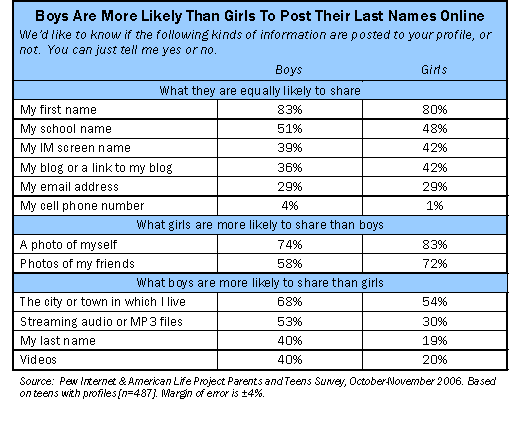
Most interestingly, a teen’s school name seems to be the exception to the general rule of withholding specific location information, or information that can be used to contact you in the real world. Some teens were concerned by it, others less bothered.
Culturally, some of the attitude differences between boys and girls may be explained by the messages transmitted to girls about their own safety and the need to protect themselves through different rules and expectations set in homes for girls and boys.
As one older high school boy put it: “Girls are more vulnerable than guys are… I have two older sisters and my parents tell me that all the time. They let me get away with stuff that they never got away with.”
Another older high school boy noted: “I have an older sister and a younger sister, and I watch over my little sister. They are kind of like are more lenient when she’s with me. But if she’s not, she’s in at 10:00. If she’s with me, she can come home at like three, four in the morning.”
Older teens share more personal information than younger teens.
Younger teens and older teens have different information sharing practices as well. Older teens ages 15-17 with online profiles are more likely than younger teens to post photos of themselves or friends to their profile as well as share their school name online. Older girls are more likely than any other group to share photos of friends, while younger girls are more likely than younger boys to have shared information about their blog on their profile.
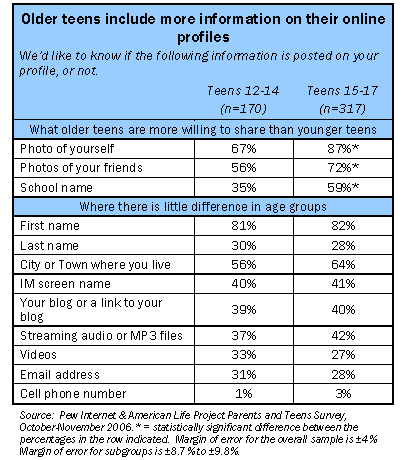
Our focus group participants were aware that parents and other adults might see their profiles. A middle school girl said this: “When I’m on MySpace I will never put anything on it that I wouldn’t want my parents to see. People have stuff, my friends have stuff like ‘What Victoria Secret model are you?’ And a picture of a girl in lingerie.”
[admit you]
We conducted a similar activity in our focus groups in which we asked teens to categorize various pieces of personal information into groups that were never okay to share, which were okay to share under certain circumstances and those which were almost always okay to share online.
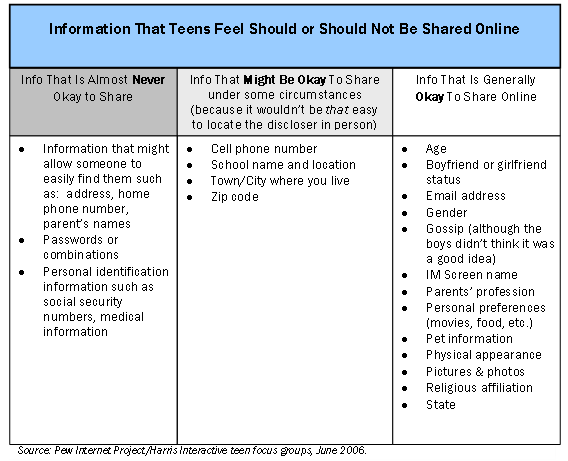
[My town]
Teens with profiles are more likely to share certain pieces of personal information offline than online.
In an offline setting, teens are most guarded about their phone numbers.
There are always a certain number of “transparent” teens who say they will share most any piece of information offline, and teens who are very private and will not share any information under any circumstances. But in between, a cohort of teens strike the balance between being open enough to start down a road towards friendship (or more) but also being aware of their personal responsibility to protect their privacy and that of their family.
For offline privacy among teens, there are distinct lines drawn over information that is okay to share with a new acquaintance and information that you would not share at a first meeting. The information deemed most “okay” to share with someone you had just met at a party include the state you live in, the name of the school you go to, the city or town where you live and your IM screen name. Information that is regarded as more private when sharing in person includes a link to your blog, your cell phone number and most private of all – your home phone number.
“my question to you is if its ok to tell ur school name, why isnt it ok to tell ur school location? they can find that anywhere online.”
– Boy, Late High School.
In an offline environment, for almost every piece of information we presented that is not related to internet-based contact, boys are much more likely than girls to say that it is okay to share personal information (like your last name, city and state where you live, cell phone number, school name, etc).
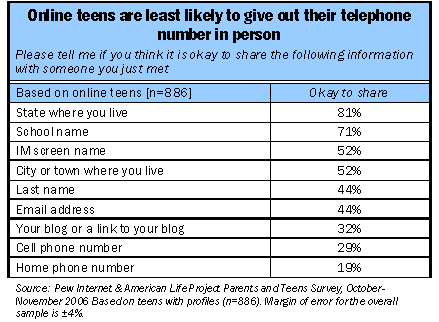
For almost every piece of information except home phone number, older teens are much more likely than younger teens to say it is okay to share it offline with someone you just met.
And of course, much of this depends on context. If you share the state where you live and go to a high school with a relatively generic name like “Eastern High” then revealing those pieces of information is not likely to be giving away much important information about yourself. But for young people who live in small towns, or who go to small and more uniquely-named schools, giving away your state and the name of your school might be all the information someone needs to show up at the front door of the schoolhouse.
Teens are more likely to say it is okay to share certain types of personal information in an offline social situation than they are to actually post that information to their online profile.
Teens who have online profiles are generally more likely to say it is okay to give out certain pieces of personal information in offline situations than they are to have that information actually posted to their profile. Teens with online profiles have a greater tendency to say it is okay to share where they go to school, their IM screen name, email address, last name and cell phone number with someone they met at a party, when compared with the percentage who actually post that information online. The only piece of information they are more likely to share online is the city and state where they live. This type of information is seen as innocuous and as something that helps new and long-lost friends locate each other on social networking websites.
In our focus groups, teens told us they are generally more comfortable sharing information at a party because they have much more contextual information in an offline setting than an online one – they can see the person, their mannerisms, and tone of voice. They can see how they deal with and treat other people when not directly interacting with you. In addition, they have landed at the same party as you – and in many cases, that means that they have some sort of connection and know people in common. Much of this contextual information is not available online. Teens do not always have the same level of familiarity with their audience and they are cognizant of these differences between online interactions and real-life ones.
In our focus groups, we asked teens whether or not they were surprised by the material that some of their peers posted to their social networking profile. Some online teens expressed shock at the nature and content of some postings. One older high school boy told us “I am sometimes kind of surprised by HOW MUCH information is revealed by someone.” Another early high school-aged girl said “Sometimes I’m surprised by the amount of sexual language used on posts, but with the fastness of our culture today I’m not too surprised.” Other teens cast a critical eye towards some of the stories told on profiles. “Sometimes people tell about doing drugs, drinking, partying that you wouldn’t expect from them but it’s hard to tell if they do these things a lot or a little because they can’t provide a good explanation,” said one early high school girl. “…most of the time I think it’s exaggeration, not usually a blatant lie but I have no way of judging if I don’t know them well.” And still other teens expressed a complete lack of surprise at anything found online. “Nothing really surprises me because you can find all kinds of people online,” said one late high school-aged girl.
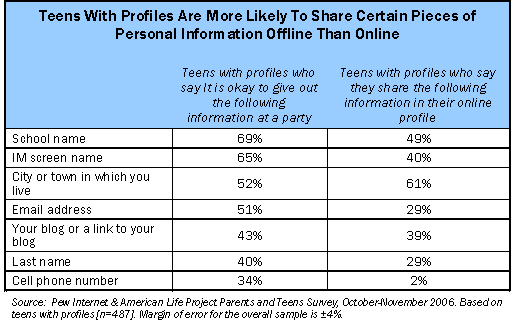
More than half of teens post false information in online profiles.
While some teens choose to withhold certain types of information from their profile, other teens take additional protective (or playful) measures such as posting fake information in their profile. Of all teens with online profiles, 56% of teens have posted at least a few pieces of false information. A little less than a third of profile owners say that “a little” of the information on their profile is false and one in six (17%) say that some of the information in their profile is made up. Eight percent of teens with online profiles say that most or all of the information on the profile is fake. And 44% of teens with profiles say that their profile is completely truthful and that none of the information on it is false.
“I have never pretended to be someone else,
I just don’t put any information on the sites
that could be dangerous to me.”– Girl, Late High School
Boys are more likely than girls to report posting fake information to their online profiles. Nearly two-thirds (64%) of boys with online profiles say that they’ve got at least a little false information posted to that profile, while just half (50%) of girls say the same.
Younger teens are more likely to say they have fake information on their profiles than older teens. Nearly 7 in 10 (69%) younger teens 12-14 say they’ve got false information on their profiles, while less than half (48%) of older teens 15-17 say they’ve posted untrue information to their online profiles. Some of this false information posting by younger teens may be related to age restrictions on some social networking sites that require that users be older than 13, meaning that 12 and 13 year old teens must lie about their age to use the sites.
“I say instead of being 14 I’m 15… No one
wants to talk to a 14-year old. So why not
just add another year? And I’m a sophomore
so I was born in August.”– Boy, Early High School
“I said I’m 60.”
– Boy, Middle School
While over half (54%) of teens who have profiles that are visible to anyone say that they have entirely truthful information on their profile, just 39% of teens with friends-only profiles say that everything posted to their profile is true. Or put another way, 46% of teens with visible profiles have posted some amount of fake information on their profile, compared with 61% of teens who have posted false information to their private profile.
“Mine says I’m from Egypt.”
– Girl, Early High School
I don’t want anyone to know where I’m from. You don’t need the people that you know to be able to read where you’re from because they already know.”
– Girl, Middle School
Rural teens are more likely to be fully truthful on their online profiles than their suburban or urban compatriots. More than half, 52%, of rural teens with online profiles say that all the information posted to their profile is true. In comparison, 41% of suburban teens and 42% of urban teens say that all the information on their online profiles is true.
Put another way, 48% of rural teens say they have posted fake information to their online profiles, while 59% of suburban teens and 58% of urban teens have done the same.
Teens struggle to find the balance point between sharing details that will facilitate meeting peers with similar interests and keeping themselves safe from unwanted online attention. When asked how easy it would be for someone to “find out who you are from your profile,” most teens occupy a middle ground between total disclosure and complete closure; 40% of teens who have an online profile say that someone would have to work at it, but would be able to figure out eventually who they were if they tried hard enough. Another third of teens (36%) say that it would be very difficult for someone to find out who they were from their profile, and about one quarter of teens with profiles say that it would be “pretty easy” for someone to identify them from their online materials.
“I use a pseudonym, who is 24. Because I
regard myself as an intellectual, it’s easier
to be taken seriously if people don’t know
they’re talking to a 16 year old. You’d
be surprised what respect 8 years buys you.”– Boy, Late High School
Younger teens are more likely to believe that they are very difficult to find online from the information posted in their online profile, while older teens believe that they are relatively difficult to find, but that a determined person could eventually track them down. Half of younger teens think that it would be very difficult to figure out who they are from their online profile. Another third (33%) think it would be hard to find them, but that eventually someone could figure it out. And 15% think it would be easy to find them online from their profile. Older teens, by contrast, are a little more sanguine about how findable they are. Just 26% think they’re truly very difficult to find from their profiles. Another 45% think that they are difficult to find, but that someone could eventually figure out who they are, and 29% think that they are easy to find from their online profiles.
Girls are less likely than boys to say that they are easy to find online from their profiles. Only 19% of teen girls with profiles say that they are easy to find, while 28% of boys say the same. The differences are less distinct for the moderately difficult to find and very difficult to find – the differences between boys and girls for these categories are within the margin of error.
“Well, everyone saw those things on the news how MySpace is killing children and so after they say that they were like, ‘Okay, make sure you go through your friends list, make sure there’s no one there that you don’t know.’ Personally, I think that if you befriend people you don’t know and/or put information on there that can help them, like your phone number or where you live, that’s just stupid. (…) So I don’t do that. I know my MySpace site is private and if someone requests me, I make sure I know them.”
– Girl, Middle School
Teens who post a significant amount of false information on their profile are unsurprisingly more likely to say it would be very difficult for someone to find out who they are from their online profile. More than half (59%) teens who say that “all” or “most” of the information on their profile is fake say it would be difficult to determine who they were from their profile. Teens who say that “some” or “very little” of the information on their profile is fake are most likely to say that while it would be difficult to figure out who they were from their profile, that some one could figure it out if they tried hard enough – with 45% of the “some” or “very little” fake information providers responding that they could be found from their profile after good effort.
Teens who provide no fake information are mixed on how easy it would be to track them down – 28% say it would be easy to find them from the information provided on their profile, 37% of profile owners who are truthful say it would be difficult to find them from their profile, but it could be done, and another 35% said it would be extremely difficult to track them down based on their profile.
Teens walk the line between openness and privacy.
Not only is what teens choose to share or not in online profiles important, but also how teens choose to share that information by making profiles or online materials public or private. Social network users and others who share content online can take advantage of the privacy and restriction tools offered within the system where they share their personal information or self-created content. This can mean password protecting an account, blog or other online sharing space, or it can mean making a profile or blog posting private so that only those on a friends list or in an online network can see what you’ve posted beyond a few basic pieces of information.
Many teens with online profiles restrict access to them.
As noted previously by the Project, a large number of teens with online profiles in some way obscure or restrict access to their online information. Indeed, a total of 66% of all teens who have ever created an online profile in some way restrict access to their profiles, including making them private, password protecting them, hiding them completely from others or even taking them offline. Three in four teens who have a profile (77%) say that it is currently available online. Of those teens with an active, currently posted profile, 59% of them say that their profile is only visible to friends. Another 40% say that anyone can see their profile. There is no statistically significant difference in restricting access to profiles by sex or age.
Teens with parents who know that they have a profile online are more likely than teens with unaware parents to have their profile visible only to friends. Nearly two-thirds (62%) of teens whose parents are aware of their online profile say that their profile is only available to friends, while 46% of teens whose parents do not know about their online profile say they have set their profiles to private. For some teens, making their profile private may be a response to parental concerns regarding keeping personal information private, or it may be that they are making their profiles private to keep them away from prying parental and other adult eyes.
Teens who have an online profile are somewhat more likely to have parents who have rules about the kinds of personal information they can share with people they talk to on the internet. Fully 89% of parents of teens with profiles say they have rules about the personal information their child can share with people they talk to online, compared with 81% of parents of online teens who do not have profiles.
Half of all online teens and three-quarters of social networking teens post photos online.
Teens also take steps to restrict other kinds of material they have shared online. Digital photos, often one of the anchoring elements of online profiles and blogs, are widely posted online by teens in many different contexts. With the proliferation of digital cameras and cell phone cameras, in particular, many teens have the means to document the most mundane and profound moments of their lives. They can then share these photos with family, friends or the world at large by posting them online to their profiles or to popular photo sharing sites like Flickr. About half of wired teens (47%) say they upload photos online where others can see them. In comparison, 73% of teens who use social networking post photos compared with just 16% of non-SNS teens.
Girls eclipse boys in photo posting.
Girls are far more likely to have posted photos online when compared with boys; 54% vs. 40%. Older teens are also more active posters 58% of teens ages 15-17 post photos vs. 36% of younger teens ages 12-14. Older girls are more seasoned posters, with 67% of them uploading photos, compared with 48% of older boys. Younger girls and boys are equally as likely to upload photos; 39% of younger girls ages 12-14 upload photos while 33% of younger boys do so.
Teens that live in homes with high-speed internet access are better positioned to upload content, and it shows. While 51% of broadband teens upload photos online, just 39% of dial-up teens post photos. Likewise, teens that are online frequently are more engaged with photo posting; while 59% of those who go online daily post photos, just 35% of teens who go online several times per week have uploaded photos.
Teens that go online most often from home are considerably more likely to post photos when compared with those who are primarily at-school users.9 About half (51%) of online teens who access the internet mostly from home have uploaded photos, compared with 36% of those with primary access at school. Many schools block social networking sites on their school networks, so many young people with access primarily at school may have fewer opportunities to upload photos, as those sites are for many a primary photo-sharing space.
Most teens restrict access to their posted photos – at least some of the time. Girls are more conservative about restricting access to photos.
Few teens who upload photos online consistently publish them without any restrictions. While 39% say they restrict access to their photos “most of the time,” another 38% report restricting access “only sometimes.” Just 21% of teens who post photos say they “never” restrict access to the images they upload.
Girls are more likely to restrict access to their photos (“most of the time”) when compared with boys; 44% of girls who post photos regularly restrict access, while 33% of photo-posting boys do so. Older girls are even more protective of their images, with 49% of photo-posting girls restricting access most of the time vs. 29% of photo-posting older boys.
“i try to post as little information as possible. there is no way of knowing who is going to see the information posted and i’m really stingy. i don’t think it’s okay to share last names, date of birth, where i live, anything that will help people identify me. pictures are OK because it’s really difficult to find someone if the only thing you know about them is what they look like.”
– Girl, Early High School
One in five social networking teens have posted video files online. Boys lead the video-posting pack.
While just 14% of all online teens say they have uploaded a video file online where others can watch it, 22% of social networking teens report video posting. And in a striking departure from the trends observed with photo posting, online teen boys are almost twice as likely as online teen girls to post video files (19% vs. 10%). Not even the highly-wired and active segment of older girls can compete with boys in this instance; 21% of older boys post video, while just 10% of older girls do so. Overall, 57% of all online teens have watched a video on a video sharing site like YouTube or GoogleVideo.
Videos are not restricted as often as photos.
For the most part, teens who post video files want them to be seen. Just 19% of video posters say they restrict access to their videos “most of the time.” As previously mentioned, that compares to 39% of photo posting teens who “most of the time” set limits on who can view the photos they post. Over one-third of teens who post videos (35%) say they restrict access to their videos “only sometimes” and 46% say they “never” limit who can watch their videos.
The group of teens who post videos (n=124) is too small to note any significant variations in privacy restrictions according to gender, age or other demographic characteristics. It is also important to note that when teens say that they have restricted access to content they have posted online, it may mean making it visible only to friends, and it also may mean flagging it as content that is only appropriate for adults.
Posting photos and videos starts a conversation. Most teens receive some feedback on the content they post online.
The posting of content does not happen in a vacuum. Teens and adults post content so that it might be seen by an audience, regardless of how that audience is limited by restrictions set on the content by the content poster. And sometimes that audience responds to the content posted online, making the content as much about interaction with others as it is about sharing with them. About half (52%) of teens who post photos online say that people comment or respond to their photos “sometimes.” Another third (37%) say that their audience comments on their posted photos “most of the time.” Only 10% of teens who post photos online say that people “never” comment on what they have posted.
Video posters report a similar incidence of commenting on the videos they post online – a little under half (48%) say that people “sometimes” comment on their video postings. A quarter (24%) say that people comment on their online videos “most of the time.” Another quarter (27%) say that they “never” get comments on posted videos.
Teenagers’ disclosure of personal information does not follow clear patterns.
Whether in an online or offline context, teenagers do not fall neatly into clear-cut groups when looking at the type of information they are willing to disclose or the ways they restrict access to the information that they do share. For instance, those who restrict access to their profiles are not always more forthcoming with the range of information they share, but neither are they completely conservative across the board. Likewise, those who restrict access to their profile are actually more likely to post fake information there, rather than the other way around. Perhaps this is because teens are referring to the basic placeholder information that is posted to the “front page” of one’s profile – which is visible to anyone, even when the rest of your profile is restricted – or perhaps these teens who post fake information to a friends-only profile are simply more comfortable joking around and being silly with friends.
Still, there are general tendencies that ring true across many of the different scenarios we posed. Older teens post more personal information to their profiles in a more public manner when compared with younger teens. Girls are more reticent about posting personal information online than boys. In our focus groups, young women and the younger boys told us that their main concern when thinking about what information to share online was how easy it would be to physically contact them in person because of access to that information. Teens make a serious distinction between online harassment and physical harm, and that distinction informs many of the choices they make to share online.
Most teens have a good grasp of how easy it would be to find them online – the majority of teens with profiles believe that they’ve taken enough steps to protect their privacy from all but the most determined online searcher.
But perhaps the most important takeaway is that decisions about privacy are highly context dependant: How much information have you shared? Is it all true? Is your profile private? Do you live in a small town or big city? How did you create your network of online “friends?” How old are you? Are you male or female? Do your parents have lots of rules about internet use? Do your parents view your profile? All these questions and more inform the decisions that teens make about how they share themselves online. Many, but not all, teens are aware of the risks of putting information online in a public and durable environment. Many, but certainly not all, teens make reasonable, informed choices about what to share in what context.
Social network use and online self-presentations for teens combine the difficult recipe of tremendous facility with and enjoyment of technology, and a desire to meet, make and reinforce friendships, during a time of personal growth, risk-taking and testing. All of these factors combined with the myriad ways that teens can control the release of their online information paint a grey and fragmented portrait of teens and online privacy.



